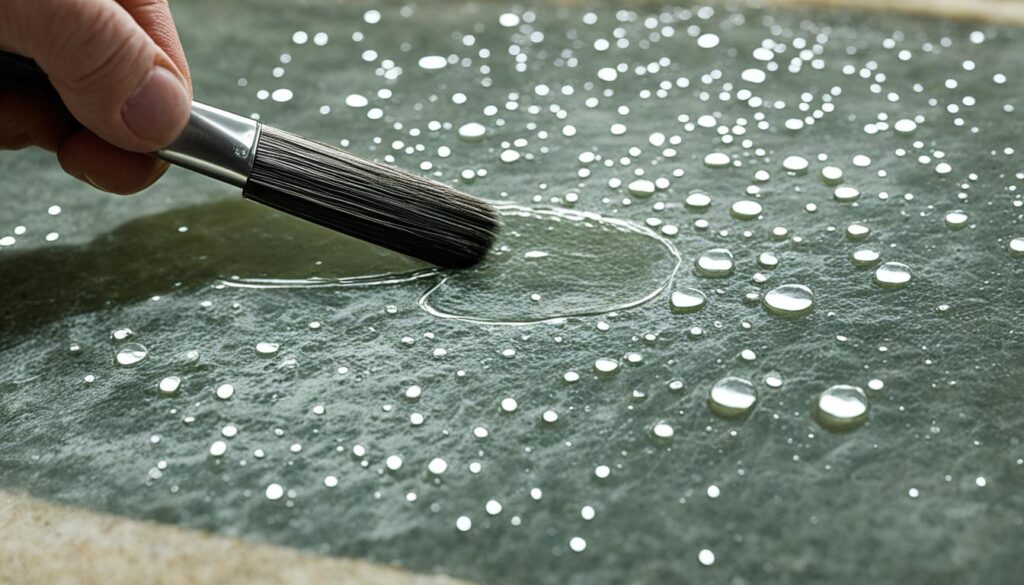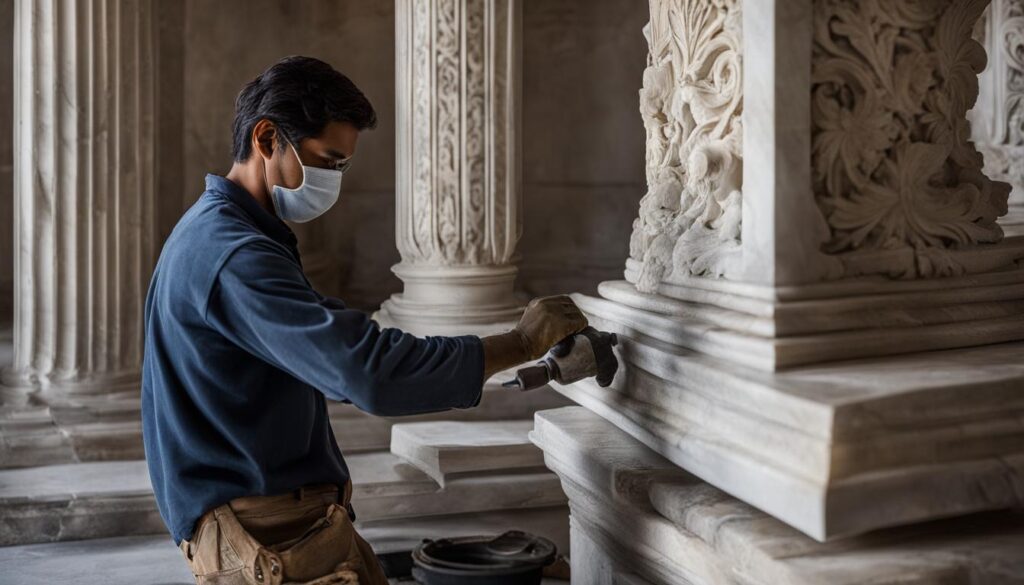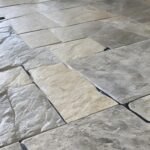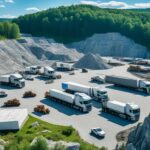Natural Stone Repair Guide – Quick & Effective Tips
Are you looking for ways to repair natural stone surfaces in your home? Whether you have marble, granite, limestone, slate, sandstone, or onyx, it’s important to know the right techniques for restoring and maintaining these beautiful materials. In this guide, we will provide you with quick and effective tips for DIY natural stone repair.
Before diving into the repair process, it’s crucial to identify the type of stone you have. This can be done by visiting a local stone mason yard, using high-quality images online, or seeking assistance from companies specializing in specific stone products. Understanding the type of stone is key to determining the appropriate repair method.
From fixing chips and missing pieces to restoring cracks and filling holes, we will walk you through step-by-step instructions for each repair scenario. You’ll also learn about proper cleaning and maintenance techniques to preserve the natural beauty of your stone surfaces.
Key Takeaways:
- Identify the type of natural stone before starting the repair process.
- Square off damaged areas and fill them with matching stone or resin repair.
- Use buff-colored resin filler mixed with pigments to match the stone color for crack restoration and hole filling.
- Regularly clean natural stone surfaces with mild or natural cleaners specifically designed for stone maintenance.
- Seal natural stone countertops to protect them from stains and etching, and reapply sealer every 3-5 years.
Identifying the Type of Natural Stone
When it comes to repairing natural stone, one of the first steps is to accurately identify the type of stone you are working with. This crucial information allows you to determine the appropriate repair method and ensure the best results for your natural stone surfaces. Here are some methods to help you identify the type of natural stone:
1. Visit a Local Stone Mason Yard
One way to identify the type of natural stone is by visiting a local stone mason yard. These yards typically have a wide selection of different stone types available, allowing you to compare the appearance and characteristics of your stone with the ones on display. The experts at the yard can also provide valuable insights and guidance regarding the specific stone types.
2. Use High-Quality Images Online
If visiting a stone mason yard is not feasible, you can rely on high-quality images available online. Look for reputable sources that provide detailed images of various natural stone types. Compare the patterns, colors, and textures of your stone with the images to determine a probable match. It’s important to choose images from reliable sources to ensure accurate identification.
3. Seek Assistance from Specialized Stone Companies
In some cases, the naming of natural stones can vary or be confusing. If you encounter difficulties in identifying your stone, consider reaching out to companies specializing in specific stone products. These companies often have experts who can help you identify the type of stone based on visual characteristics. They can provide valuable insights into the best repair methods and maintenance practices for that specific stone.
Remember, when identifying natural stone, visual characteristics are more important than just the name. Look for patterns, colors, textures, and other distinctive features that can help you accurately determine the type of stone. Understanding the specific type of natural stone is crucial for choosing the appropriate repair techniques and achieving optimal results.
| Natural Stone Type | Appearance | Characteristics |
|---|---|---|
| Marble | Distinct veining and a variety of colors | Soft and porous, susceptible to acid etching |
| Granite | Durable, speckled appearance with a wide range of colors | Less porous and more resistant to acids |
| Limestone | Soft, often with fossils and a light color | Very porous and sensitive to acidic substances |
| Slate | Dark and smooth with a layered appearance | Durable, but can be prone to chipping |
| Sandstone | Various colors with a grainy appearance | Soft and porous, requiring careful maintenance |
| Onyx | Translucent with vibrant colors and unique patterns | More fragile and sensitive to acid-based cleaners |
Repairing Chips and Missing Pieces
When it comes to fixing chips in stone or repairing missing pieces in natural stone, it’s important to follow the right approach to ensure a seamless and durable restoration. By understanding the process and using the right techniques, you can effectively repair and restore the beauty of your natural stone surfaces.
Repairing small chips in stone can be done using resin repair. Start by squaring off the damaged area to create a clean and even surface. Then, carefully fill the chip with a matching piece of stone and apply the resin. The resin will bond with both the existing stone and the new piece, creating a strong and invisible repair.
If you’re dealing with deep scratches or cracks, using a water clear resin is recommended. This type of resin has excellent filling properties and can effectively repair larger damages. By carefully applying the resin and smoothing it out, you can achieve a smooth and seamless finish.
It’s important to note that the ability to achieve a perfect match depends on various factors. The size of the damage, its position in the stone, and the lighting conditions in the area can all impact the final result. However, with proper technique and attention to detail, you can achieve a restoration that blends in flawlessly with the rest of the stone.
Important Steps for Repairing Chips and Missing Pieces:
- Square off the damaged area to create a clean surface.
- Fill the chip with a matching piece of stone.
- Apply resin repair for small chips, or water clear resin for deep scratches or cracks.
- Smooth out the repair to achieve a seamless finish.
- Consider factors such as the size of the damage, position in the stone, and lighting conditions for a perfect match.
Remember, attention to detail and proper technique are key to achieving a successful repair. By following these steps, you can effectively fix chips and repair missing pieces in your natural stone surfaces, restoring their beauty and durability.
Restoring Cracked Natural Stone
To restore cracked natural stone, it is important to thoroughly clean the stone before starting the repair. Cracks along the veins of the stone can be repaired using a buff-colored resin filler mixed with pigments to match the stone color. The excess filler should be removed, and the surface can be sanded for a finer finish. Proper cleaning and working in small areas are key to achieving successful crack restoration.
Cracked natural stone can be a common issue that homeowners and property owners face. Whether it’s a crack in a marble countertop or a fissure in a limestone floor, addressing these cracks is essential to maintain the beauty and structural integrity of the stone. With the right techniques and materials, you can restore cracked natural stone and bring back its original charm.
To begin the restoration process, thorough cleaning of the stone surface is crucial. Use a gentle stone cleaner and a soft cloth to remove any dirt, dust, or debris from the cracks. This ensures that the filler adheres properly and provides a seamless repair.
Next, select a buff-colored resin filler. This filler should be mixed with pigments that match the color of your stone. Mixing pigments allows for a more accurate color match, resulting in a seamless repair that blends with the surrounding stone.
Apply the resin filler to the cracks, ensuring that it fills the entire depth and width of the crack. Use a putty knife or a similar tool to carefully smooth out the filler, making sure it is level with the surrounding stone surface. It is important to work in small areas to ensure precision and avoid excessive filler application.
Once the filler is applied, remove any excess by gently scraping it off with a putty knife. This step helps achieve a smooth and even surface, minimizing the need for extensive sanding later on.
After the excess filler is removed, allow it to dry completely according to the manufacturer’s instructions. This drying process is essential for the filler to harden and bond with the stone, ensuring a long-lasting repair.
Key Steps for Restoring Cracked Natural Stone:
- Thoroughly clean the stone surface before starting the repair.
- Select a buff-colored resin filler mixed with pigments to match the stone color.
- Apply the filler to the cracks, ensuring it fills the entire depth and width.
- Smooth out the filler with a putty knife, making it level with the surrounding stone surface.
- Remove any excess filler to achieve a smooth and even surface.
- Allow the filler to dry completely according to the manufacturer’s instructions.
| Benefits of Restoring Cracked Natural Stone |
|---|
| Restores the beauty of the stone |
| Prevents further damage and deterioration |
| Preserves the value of the property |
| Extends the lifespan of the stone |
Restoring cracked natural stone is a specialized task that requires attention to detail and expertise. Hiring professional natural stone restoration services can ensure that the repair is carried out effectively and efficiently, utilizing the right techniques and materials. Professional restorers have the knowledge and experience to handle different types of natural stone, providing optimal results and peace of mind.
If you’re looking to restore cracked natural stone and maintain the beauty of your countertops, floors, or other stone surfaces, contact the experts at SLIQUE. Our team of skilled professionals specializes in natural stone restoration, offering top-quality services to ensure your stone surfaces look their best. Don’t let cracked stone detract from the elegance of your space – trust SLIQUE to deliver exceptional results.
Repairing and Filling Holes in Travertine
Travertine is a beautiful natural stone with a unique appearance. However, over time, it is not uncommon for travertine to develop holes and cracks. Repairing these imperfections is essential to maintain the stone’s integrity and aesthetics.
To start the hole repair process, it is crucial to clean the travertine surface thoroughly. This ensures proper adhesion of the repair material and a seamless finish. Once cleaned, a buff-colored resin filler mixed with pigments that match the stone color should be applied to the holes.
For small holes, a single shade of filler may be sufficient. However, larger holes might require the use of multiple shades to achieve a more natural look. After applying the filler, excess material should be carefully removed using a scraper or sanding, depending on the stone’s finish.
Working in small areas and cleaning regularly throughout the repair process ensures better results and a smoother finish. It is important to monitor the drying time of the filler and follow the manufacturer’s instructions for best practices.
Repairing holes in travertine not only restores the stone’s appearance but also prevents further deterioration. By addressing these imperfections promptly and effectively, you can prolong the lifespan of your travertine surfaces and maintain their natural beauty.
| Benefits of Repairing Holes in Travertine: | Steps to Repair Holes in Travertine: |
|---|---|
|
|
Don’t let holes and cracks diminish the beauty of your travertine surfaces. With proper repair techniques and regular maintenance, you can keep your travertine looking flawless for years to come.
Maintaining and Cleaning Natural Stone
Proper maintenance and cleaning are essential for preserving the beauty and longevity of natural stone surfaces. By following the right techniques, you can keep your natural stone looking fresh and pristine.
When it comes to cleaning natural stone, it’s crucial to use mild or natural cleaning agents specifically designed for this purpose. Harsh cleaners can cause etching or damage to the stone, compromising its integrity. Instead, opt for gentle solutions that effectively remove dirt and grime without harming the surface.
Regular maintenance involves wiping the stone surface with a damp cloth to remove dust and debris. This simple step can go a long way in maintaining the cleanliness and shine of your natural stone. In addition, occasional use of a heavier-duty cleaner can help tackle stubborn stains or build-up.
For a more thorough clean, consider using a stone-specific cleaner that is formulated to effectively remove dirt and restore the stone’s natural luster. These cleaners are designed to be non-abrasive and safe for use on various types of natural stone.
It’s important to note that different types of natural stone may have specific cleaning requirements. For example, marble may require a pH-neutral cleaner, while granite may benefit from a stone-specific degreaser. Therefore, it’s crucial to familiarize yourself with the maintenance recommendations for your specific type of stone.
Professional natural stone restoration services can also be a valuable asset in maintaining the beauty of your stone surfaces. These professionals have the knowledge, expertise, and specialized tools to handle various types of natural stone and provide optimal care.
In summary, maintaining and cleaning natural stone involves using gentle cleaning agents, regular wiping with a damp cloth, occasional use of a heavier-duty cleaner, and employing stone-specific cleaners for a more thorough clean. By following these practices, you can ensure that your natural stone surfaces remain beautiful and well-preserved for years to come.
Sealing Natural Stone Countertops
Sealing natural stone countertops is essential for maintaining their beauty and protecting them from stains and etching. Proper sealing helps to prolong the life of the countertops and preserve their natural luster. To ensure the longevity of your natural stone countertops, follow these important sealing guidelines:
- Apply a high-quality countertop sealer: Immediately after installation, apply a high-quality countertop sealer that is specifically formulated for natural stone. This will create a protective barrier on the surface of the stone, preventing liquids and stains from penetrating into it. Choose a sealer that is long-lasting and provides a strong defense against spills and other potential damage.
- Reapply sealer every 3-5 years: Over time, the protective sealant on your countertops may wear off due to regular use and cleaning. It is recommended to reapply the sealer every 3-5 years or as directed by the manufacturer. This will ensure that your countertops continue to be adequately protected and maintain their aesthetic appeal.
- Regularly clean and remove stains promptly: Proper cleaning is crucial for the maintenance of natural stone countertops. Use mild or natural cleaners specifically designed for natural stone to avoid damaging the sealant. Regularly wipe the countertops with a damp cloth to remove dust and debris. Additionally, promptly clean any spills or stains to prevent them from seeping into the stone.
By following these sealing and maintenance guidelines, you can ensure the longevity and beauty of your natural stone countertops. Remember to choose a high-quality sealer, reapply it regularly, and promptly clean any spills or stains to protect and preserve the integrity of the sealant.

Expert Tip:
“Sealing your natural stone countertops is an essential step in their maintenance. It helps in preventing stains and etching, preserving the beauty of the stone. Be diligent in regularly reapplying the sealer and promptly cleaning any spills to ensure the long-lasting protection of your countertops.” – Jane Smith, Natural Stone Restoration Expert
Tips for Dolomite Countertop Maintenance
To keep dolomite countertops, especially super white dolomite, looking brand new, specific maintenance is required. By following these tips, homeowners can ensure the longevity and aesthetic appeal of their countertops:
- Seal the Countertops: It is essential to seal dolomite countertops using a high-quality sealer. This protective layer acts as a barrier against stains, scratches, and etching caused by daily use. Apply the sealer immediately after installation and reapply every few years to maintain the integrity of the seal.
- Promptly Clean Stains: Accidental spills happen, but it’s important to clean any stains on dolomite countertops as soon as possible. Use a mild, natural stone cleaner and a soft cloth or sponge to gently remove stains without damaging the surface. Avoid abrasive cleaners or scrub brushes, as they can cause scratches.
- Use Natural Stone Cleaners: When cleaning dolomite countertops, opt for natural stone cleaners specifically formulated for this type of surface. These cleaners are pH-neutral and won’t cause any harm or etching on the stone. Regularly wipe down the countertops with a damp cloth to remove dirt and debris.
- Fill Voids: Over time, small voids or pits may appear on the surface of dolomite countertops. These voids can collect dirt and make cleaning more challenging. Fill any voids with an acrylic filler specifically designed for natural stone. Follow the manufacturer’s instructions for application and ensure a smooth, level surface.
By following these dolomite countertop maintenance tips, homeowners can enjoy a beautiful and functional surface for years to come.
Dolomite Countertop Maintenance Comparison
| Maintenance Action | Frequency | Effectiveness |
|---|---|---|
| Sealing | Every few years | Highly effective at protecting against stains and etching |
| Prompt Stain Cleaning | As soon as stains occur | Prevents stains from setting and maintains the countertop’s appearance |
| Using Natural Stone Cleaners | Regularly | Gentle and safe cleaning without causing any damage or etching |
| Filling Voids | As needed | Maintains a smooth and clean surface, preventing dirt accumulation |
Hiring Professional Natural Stone Restoration Services
While DIY repair and maintenance techniques can be effective, hiring professional natural stone restoration services can provide comprehensive care and expertise. Professional restorers have the knowledge and experience to handle different types of natural stone and can save time, money, and potential damages.
When it comes to the restoration of your valuable natural stone surfaces, it is important to trust the professionals. They understand the unique characteristics of each type of stone and have access to specialized tools and materials that ensure high-quality repairs and restoration.
Choosing a reputable restoration company like SLIQUE can provide you with peace of mind. SLIQUE is a renowned name in the industry, known for their expertise in natural stone repair and restoration. Their team of skilled technicians is trained to handle a wide range of stone-related issues, from small repairs to extensive restoration projects.
By hiring professional stone restoration services, you can:
- Ensure the proper identification of the type of stone and its specific requirements for repair.
- Save time and effort by entrusting the task to experienced professionals.
- Minimize the risk of further damage or incorrect repairs.
- Benefit from the use of high-quality materials and tools for lasting results.
- Ensure the restoration is done with precision and attention to detail.
Professional natural stone restoration services offer a range of solutions, including:
- Honing and polishing to restore the shine and smoothness of the stone surface.
- Repairing chips, cracks, and missing pieces to restore the structural integrity of the stone.
- Deep cleaning and stain removal to eliminate stubborn stains and discoloration.
- Sealing to protect the stone from future damage and maintain its beauty.
- Color enhancement to revive faded or dull stone surfaces.
When selecting a professional stone restoration company, it is important to consider their expertise, reputation, and customer reviews. Schedule a consultation with the restoration experts to discuss your specific needs and explore the options available to you.
By hiring professional natural stone restoration services, you can ensure the longevity and beauty of your stone surfaces, enhancing the overall aesthetic appeal of your space.

Client Feedback:
“I was amazed by the level of expertise and professionalism exhibited by the team at SLIQUE. They not only repaired and restored my natural stone surfaces but also provided valuable advice on maintenance. I highly recommend their services!” – Sandra Thompson, satisfied customer
| Benefits of Hiring Professional Stone Restoration Services: |
|---|
| 1. Expertise in handling different types of natural stone |
| 2. Access to specialized tools and materials |
| 3. Time and effort savings |
| 4. Reduced risk of further damage |
| 5. Use of high-quality materials and tools |
| 6. Precision and attention to detail |
Conclusion
Restoring and maintaining natural stone surfaces can be a manageable task with the right techniques and knowledge. By identifying the type of stone and understanding the specific repair methods for chips, cracks, and holes, you can effectively restore the beauty of your natural stone.
Utilizing proper cleaning and maintenance practices is crucial for preserving the longevity and radiance of your stone surfaces. Sealing your countertops, promptly removing stains, and regularly filling stone voids are essential steps in maintaining the integrity of your natural stone.
While DIY methods can be effective, hiring professional natural stone restoration services like SLIQUE can provide comprehensive care and optimal results. Their expertise and experience ensure that your natural stone surfaces are handled with precision and attention to detail.
Follow these tips and you’ll be able to restore and preserve the natural radiance of your natural stone, enhancing the beauty and durability of your surfaces for years to come.



